What the heck is a second cousin once removed?
This question — How are we related? — might arise when you gather with relatives during holidays. Or anytime.
Most people just laugh and change the subject.
But, next time, YOU can be the one who knows the answer!
(PRO TIP: Keep this post handy for reference!)
Casual Cousins
First, there’s nothing wrong with casually calling someone your “cousin” if they are related to you indirectly somehow or other. Same with referring to your mom’s best friend as “auntie”. I’ve been known to refer to people I’ve never met, but who are researching the same ancestors I am, as “genealogy cousins” because it doesn’t really matter if they’re 2nd cousins, or 3rd , or 4th. Even DNA matches are assigned a range of possible relationships depending on the number of centimorgans (cMs) you share with them.
(Don’t worry, there will be no math in this post, and no more DNA talk, either!)
Formal Cousins
But it’s fun to know relationships. And, if we’re researching for the purpose of adding someone to our family tree, we really do need to know exactly where they fit in. It also becomes important when conversing or writing about common ancestors, especially when they have similar names, to know which person we’re talking about.
There are several ways to figure out cousin relationships.
Here are the two easiest:
Cousin charts
There are many styles of cousin charts (aka relationship charts for genealogy).
Some of them look like family trees. Others look more like the Periodic Table of the Elements.
Does it make you feel better to know that even genealogists need charts to figure it out?
To my knowledge there are no “bad” (erroneous) relationship charts floating around out there, but I like this one because it is simple and makes sense to me.
(Check my Org4life Genealogy Resource Roundup for a higher resolution copy.)
It’s all about starting with the common ancestor.
Let’s say I’ve met a new cousin — Haley — and we both have Andrew J. Hankins in our trees.
I am the granddaughter of Andrew’s son George.
And Hailey is the granddaughter of Andrew’s son Perry.
We are both great-granddaughters of Andrew J. Hankins.
What are we to each other, then?
It doesn’t matter which of us is on the horizontal or the vertical axis.
If I locate myself on the vertical axis, and Hailey on the horizontal axis, and draw a line down/across until the lines meet, that’s our answer: We’re second cousins.
And what are Hailey’s children to me?
Second cousins once removed.
“Once removed” means we are separated from each other by a generation.
Ancestry.com
When you add people to your tree in their proper spots, Ancestry will figure it out for you and tell you what the relationship is. Although Haley and I have a gap in our ages, we are the same number of generations away from our common ancestor, our great-grandfather Andrew J. Hankins. Her children, then are my “second cousins once removed”. Or, as Ancestry puts it: 2nd cousin 1x removed
Other genealogists chime in
Everyone explains it a little differently, but with the same results. Sometimes it helps to hear it explained another way. So, here are a few blog posts written by trusted resources from my book — What’s a Photo Without the Story? How to Create Your Family Legacy — and from my Org4life Genealogy Resource Roundup.
- Second Cousins and Removed Cousins: What’s the Difference — Amy Johnson Crow
- Solving Cousin Relationships — Lisa Lisson
- Figuring out how you’re related — Janine Adams
A favorite cartoon
You may have seen a cartoon wherein Albert Einstein gets so befuddled by a cousin relationship question that he quickly moves on to the presumably-easier topic of general relativity. It proved to be cost-prohibitive to legitimately include the cartoon in my post, so I’m linking to it instead: Einstein’s Cousins
Has this question ever come up in your family?
Did anyone know the answer?
Does this explanation help?
What tips or tricks do you have for figuring it out?
Please share in the comments below!
——————————————————————————————————
Copyright 2022 by Hazel Thornton, Organized for Life and Beyond
Author of What’s a Photo Without the Story? How to Create Your Family Legacy
Please contact me for reprint permission. (Direct links to this page are OK!)
————————————————————————————-—————
Share this:

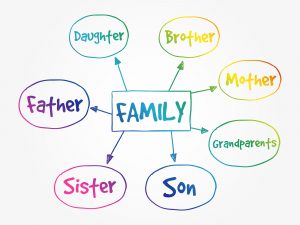
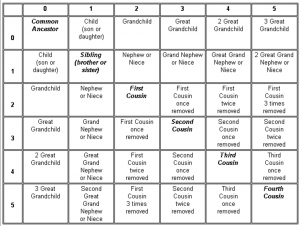
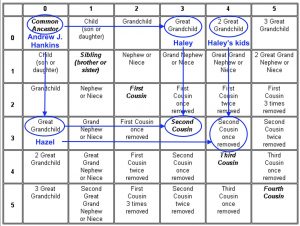

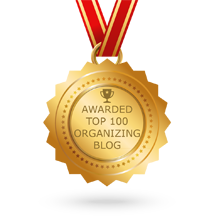

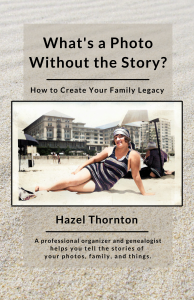
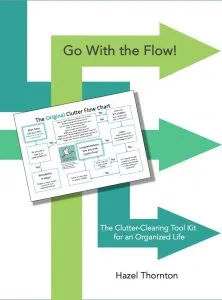
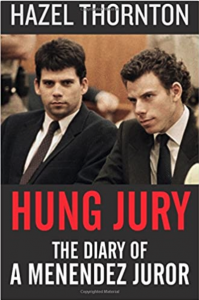
What an awesome explanation for figuring out cousin relationships! I’m good with knowing first and second cousins, but once I get beyond that, it’s been a mystery. Clearly no more. With your handy dandy chart, I can now better understand the relationships. I printed out your chart.
I also clicked on the Einstein cartoon, which is fabulous!
Oh, I’m glad it helped!
Interesting post – I may have to go back on Ancestry now that I have all of my parents photos. As the oldest I took the responsibility of them. My mom did nothing with them. They were everywhere and in no order. There was a ton of them.
I did divide them up and pass some on to my siblings.
My partner is First Nations and it is interesting how they are in the world. Everyone is an auntie and a cousin. If they are somehow related they have a title as such. Or in general they are sisters and brothers.
PS. I purchased your book.
You buried the lead — I hope you enjoy my book! And thanks for commenting, too. Yes, I have Mexican-descent friends who also lump everyone together as cousins without regard to actual relationships. 🙂 Good luck with your photo project!
Thanks for explaining how to figure out Cousin relationships.
There is a report I use on my Family Tree Maker app called the “Relationship” Chart. It usually starts with my kids and shows what the relationship they are to the name on the family tree. It’s a lengthy report, but I added this to the Heritage Scrapbook I created recently.
I’ve always wondered about this “once removed” thing. That was so easy to understand. Thank you for this illustration. I do think I’ll keep it around for reference. It can get pretty confusing, right?
This chart is invaluable. I am always tripped up by these relationships and my daughter always wants to understand how we are related to each person in our family. She wants “the word.” I just shared this post with her
I’m glad you found it useful!